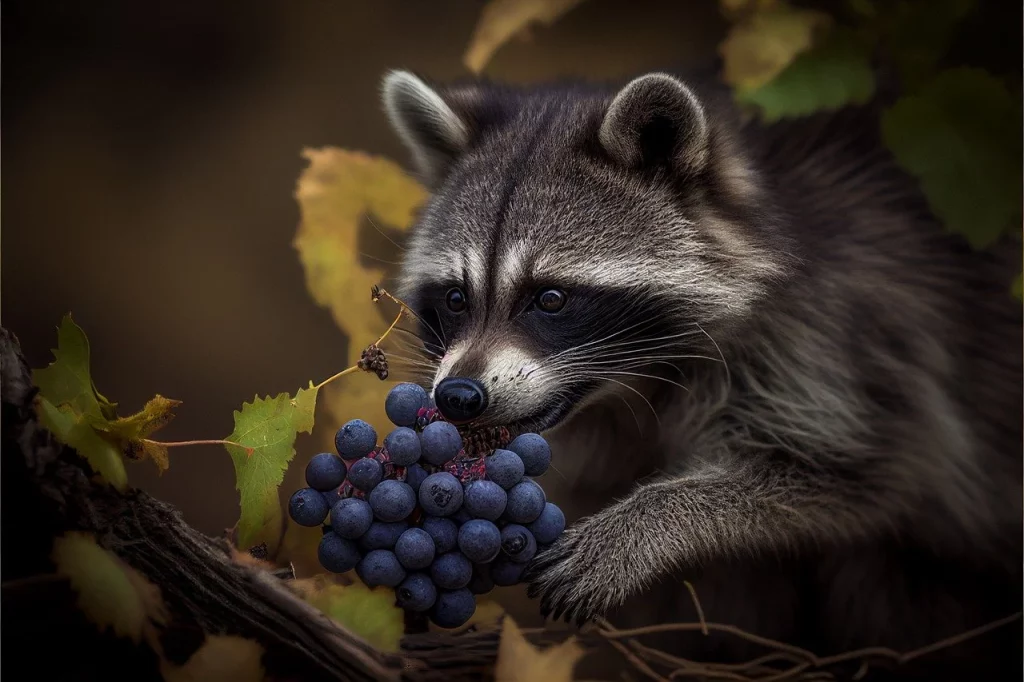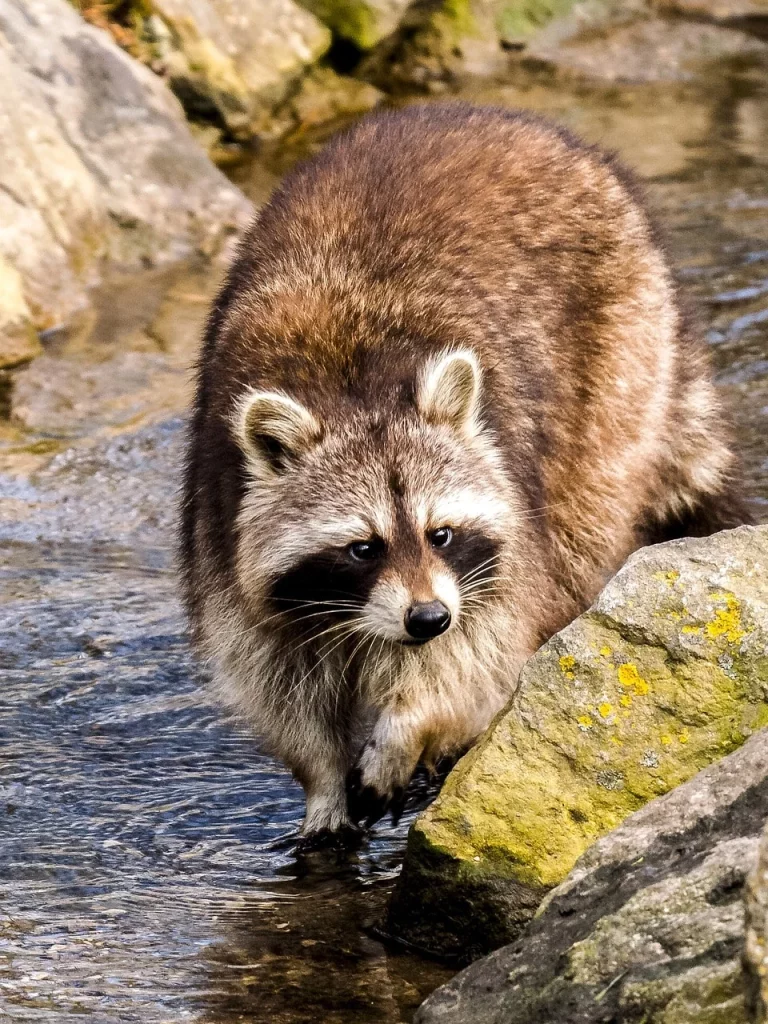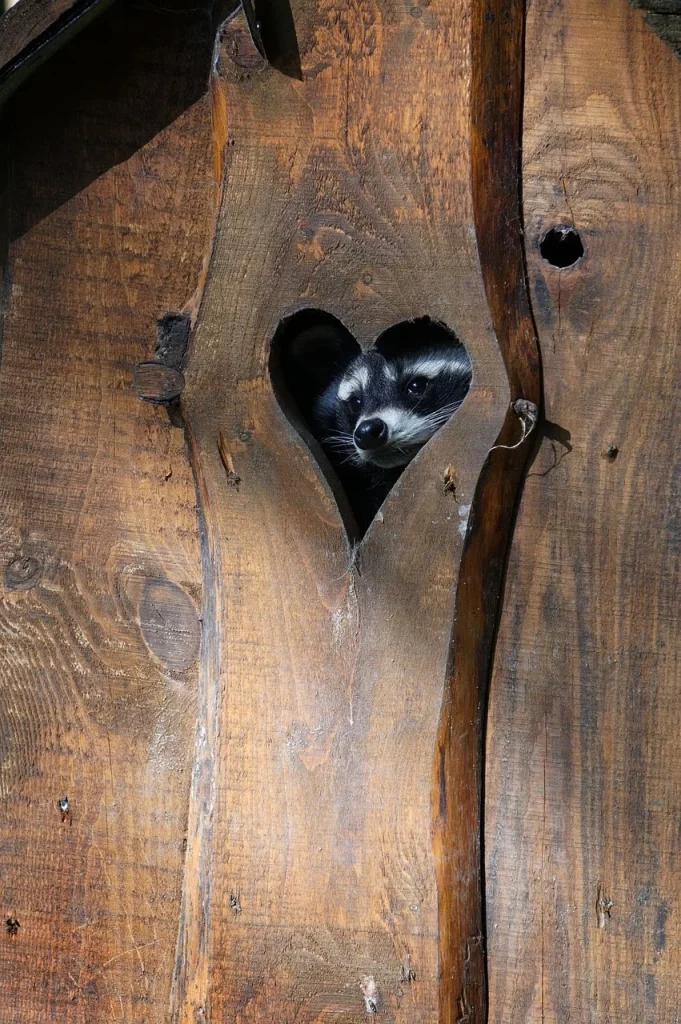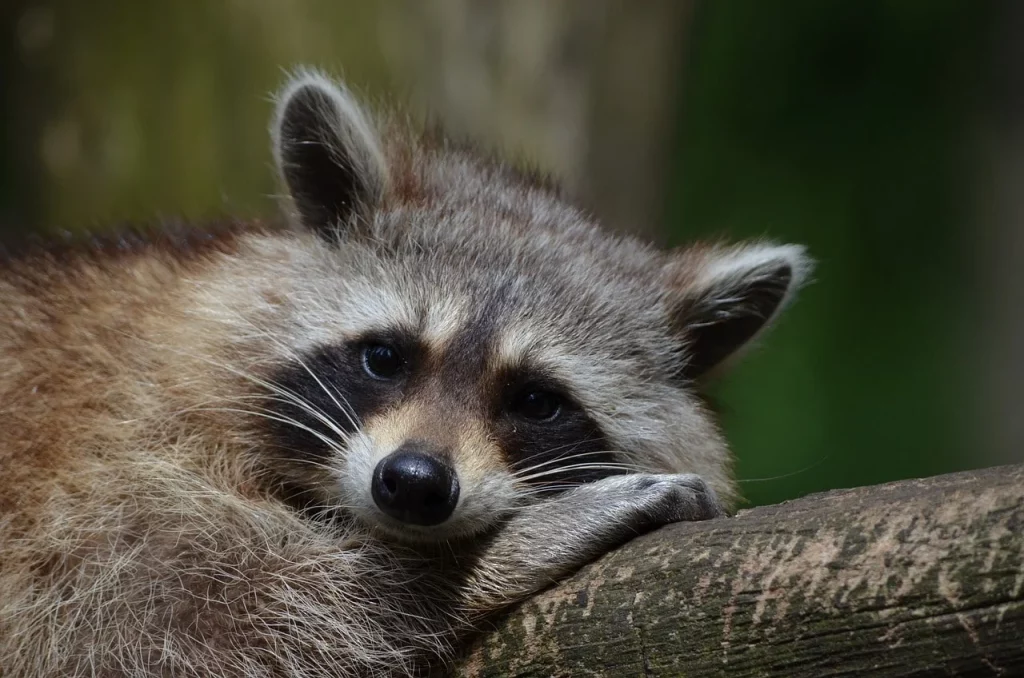Have you ever spotted a raccoon rummaging through your trash and wondered what they’re all about? Well, you’re in for a treat! They are fascinating creatures with more quirks than a superhero’s sidekick.
From their tiny thief-like masks to their surprisingly clever paws, these little bandits have been captivating hearts and securing trash bins around the world. Today, we’re diving into the world of raccoons with some interesting facts that will make you see these furry adventurers in a whole new light.
Did you know raccoons have their own version of a dinner wash ritual? Yes, they’re the unexpected gourmets of the animal kingdom! So, are you ready to become a raccoon trivia champion?
Raccoons are not just survivors; they are conquerors of their domain.
David Suzuki
Raccoon Facts
Let’s start our journey with all these fun facts about raccoons. Read carefully, because I created a quiz for you at the end of this article to test your knowledge. Will you be able to prove your expertise?
- These creatures possess remarkable dexterity, allowing them to open jars, door latches, and even unlock cages.
- Originally, they were not found in large parts of Europe and Asia but have been introduced by humans and are now thriving in these regions.
- In the wild, their life expectancy is only about 2 to 3 years, although in captivity, they can live up to 20 years.
- They are known for their unique ‘washing’ behavior, where they appear to wash their food before eating, although this action is actually a tactile examination rather than cleaning.
- Their name comes from the Powhatan word raccoon, which means “animal that scratches with its hands.”
- These creatures have a very high metabolic rate, which means they can eat a wide variety of foods and often scavenge human trash.
- They can descend a tree headfirst by rotating their hind feet so they can point backwards.
- They possess a layer of fat up to 4 inches thick to help them survive in cold weather.
- Their masks are not just for show; they help reduce glare and enhance their night vision.
- They are solitary animals but can come together in a communal den for warmth during severe winter weather.
- Their vocalizations include more than 50 different sounds to communicate.
- Urban individuals tend to be heavier than their rural counterparts due to access to human food waste.
- They have a great memory for solving problems and can remember solutions for up to three years.

- Although they have poor vision, they have highly sensitive hands that are more touch-sensitive than those of humans.
- They are capable of running at speeds of up to 15 miles per hour.
- Each individual’s mask and tail rings are unique, much like a human fingerprint.
- They can use their five-fingered hands to manipulate objects in complex ways, similar to primates.
- Male raccoons are called boars, while females are known as sows, a terminology shared with pigs.
- They have been known to play dead when caught by predators, only to make a quick escape when the predator loses interest.
- Their den sites can be anything from tree holes, abandoned burrows, or even human-made structures.
- In some cultures, they are considered a culinary delicacy, while in others, they are seen as pests.
- During the mating season, a male can become aggressive and travel great distances to find a mate.
- Babies are born blind and completely dependent on their mother for the first two months of their lives.
- They have a special tooth structure that allows them to rotate food, much like humans do with their hands when eating.
- Their tails, which can be as long as 12 inches, help them balance when climbing.
- The night vision of these creatures is exceptionally good, allowing them to navigate and hunt in the dark.
- They are excellent swimmers and can stay in the water for several hours if needed.
- Diseases such as rabies, distemper, and parvovirus can be transmitted to humans and pets.

- They can create complex social structures, often forming small, loosely organized groups.
- Footprints of raccoons are so distinctive that they are often used in tracking by hunters and naturalists.
- Despite their common image as trash pandas, they play a significant role in the ecosystem by controlling insect and rodent populations.
- They have a double-layered coat that helps them stay dry and insulated in wet environments.
- Some cities have reported that smart individuals have learned to use traffic lights to safely cross roads.
- Their ability to adapt to various environments has made them a subject of study in urban ecology.
- Raccoons are sometimes active during the day, especially the mother while searching for food for her young.
- Their whiskers are not just on their faces, but also on their wrists, which helps them sense their environment.
- They have a unique adaptation in their digestive system that allows them to digest a wide variety of foods, from fruits to fish.
- Intelligence tests have shown they can solve complex locks in less than ten tries and remember the solutions for years.

- They are one of the few animals capable of opening complex locks and remembering the sequence for up to three years.
- Their paws are incredibly sensitive to touch and are capable of feeling the texture and shape of objects without visual aid.
- Raccoons have a zoonotic disease called Baylisascaris procyonis, a roundworm that can be harmful to humans and other animals.
- In some regions, they are considered invasive species due to their impact on native wildlife and ecosystems.
- They can rotate their hind feet 180 degrees, which helps them climb down trees headfirst.
- The black “mask” of fur around their eyes is believed to help reduce glare and enhance their night vision.
- Raccoons have been observed to remember the solution to tasks for up to three years, highlighting their problem-solving skills and memory.
- They sometimes use tools to obtain food, such as using rocks to smash open shellfish.
- Their vocalizations can convey different meanings, from calls for mating to expressions of distress.
- Raccoons are known to have a polygynous mating system, where one male mates with multiple females.
- Despite their common portrayal as mischievous thieves, raccoons are very cautious and intelligent animals that avoid confrontation.
- A group of raccoons is called a nursery.
Raccoon Myths

I hope you enjoyed the previous section, because now we are going to uncover some myths. Let’s find out the actual truth behind some common misconceptions.
- Raccoons are purely nocturnal creatures.
While it’s commonly believed that they only come out at night, they can be active during the day as well, especially when food is scarce or when a mother is searching for food for her young. Their activities are not strictly limited to the night. - Raccoons wash their food before eating.
This behavior is often misinterpreted as washing. In reality, raccoons lack sweat glands, so wetting their food is a way to enhance their tactile sensation and gather more information about what they’re about to eat. - Raccoons are always solitary animals.
They are usually thought of as solitary, but they can form loose, temporary groups or families. Female raccoons are known to share dens during the colder months or while raising their kits, showing a level of social behavior. - Raccoons are dangerous pests.
Although they are often seen as pests due to their scavenging habits, they play a crucial role in their ecosystem by controlling insect populations and spreading seeds. They are opportunistic animals that adapt to various environments. - Raccoons make good pets.
Despite their cute appearance and apparent tameness, they are wild animals with unpredictable behavior. They are not suited to domestic life, as their natural instincts can lead to destructive and aggressive behaviors when kept in a home environment.
No products found.
Raccoon Quotes

Below, you will find some of my favorite quotes about raccoons. Feel free to share yours in the comments so I can add them to the list as well.
The intelligence of raccoons always amazes me. They can turn the world into their playground.
Jane Goodall
Jane Goodall, renowned for her work with primates, admires the cleverness and playful nature of raccoons.
In the eyes of a raccoon, every human is a potential friend or foe. Their trust is earned, not given.
John Muir
John Muir, a naturalist, reflects on the cautious yet curious demeanor that raccoons exhibit towards humans.
To understand the raccoon is to unravel the mysteries of the forest.
Rachel Carson
Rachel Carson, a marine biologist and conservationist, sees the raccoon as a key to comprehending the complexities of forest ecosystems.
Raccoons teach us that curiosity doesn’t kill; it makes life more thrilling.
Sir David Attenborough
Sir David Attenborough, a broadcaster and natural historian, celebrates the raccoon’s curiosity as a vital part of its charm and survival.
Watching raccoons, I realize how much we underestimate the nightlife of the animal kingdom.
Gary Snyder
Gary Snyder, a poet known for his environmental activism, points out the raccoon’s nocturnal activities as a window into the unseen lives of wildlife.
Raccoon FAQ

Before you jump into the trivia, it’s important to focus on the answers to these common questions. Read carefully if you want a perfect score on the upcoming quiz.
- Can raccoons swim?
Yes, they are excellent swimmers! They’re often seen swimming in natural bodies of water, using their swimming skills to find food or escape predators. - Are raccoons rodents?
Nope, they are not rodents. They belong to the Procyonidae family, which makes them more closely related to bears and weasels than to mice or rats. - What do raccoons eat?
They are not picky eaters. They’re omnivores, which means they enjoy a varied diet that includes fruits, nuts, insects, eggs, and even small animals. They’re also known to rummage through trash cans for leftovers! - How long do raccoons live?
In the wild, they typically live 2 to 3 years, but with fewer threats in a more controlled environment, they can live up to 5 years or more. - Are raccoons nocturnal?
Yes, they are primarily nocturnal creatures, meaning they are most active at night. This is when they do most of their foraging and exploring.
No products found.
Raccoon Trivia

Welcome to the raccoon quiz, where the stakes are high and the trash cans are on lockdown. Score zero, and we’ll send a bandit-masked raccoon to rearrange your sock drawer at midnight!
Conclusion
Raccoons have a way of reminding us of the beauty and complexity of nature. With their dexterous paws and masked faces, they navigate the world in a manner that’s both endearing and mysterious.
They remind us that even in our backyards, there are wonders to be discovered and stories to be told. As we share our spaces with these resourceful creatures, let’s strive to coexist peacefully and protect the natural habitats that sustain them.
By understanding and respecting raccoons, we can foster a deeper connection with the natural world around us. Till next time, stay curious and explore more. Cheers.
3 Sources Used For This Article

